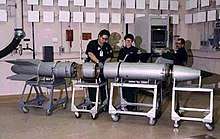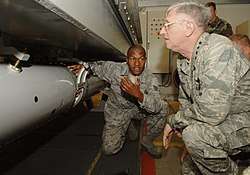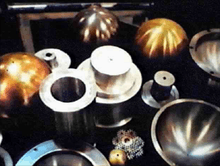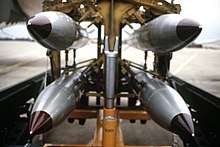B61 nuclear bomb
The B61 nuclear bomb is the primary thermonuclear gravity bomb in the United States Enduring Stockpile following the end of the Cold War. It is a low to intermediate-yield strategic and tactical nuclear weapon featuring a two-stage radiation implosion design.[4]
| B61 | |
|---|---|
 B61 training unit intended for ground crew. It accurately replicates the shape and size of a "live" B61 (together with its safety/arming mechanisms) but contains only inert materials | |
| Type | Nuclear bomb |
| Service history | |
| Used by | United States |
| Production history | |
| Designer | Los Alamos National Laboratory |
| Designed | 1963 |
| Manufacturer | Pantex Plant |
| Unit cost | $28 million (Mod 12)[1] |
| Produced | 1968 (full production) |
| No. built | 3,155 |
| Variants | 12 |
| Specifications | |
| Mass | 700 pounds (320 kg) |
| Length | 11 feet 8 inches (3.56 m) |
| Diameter | 13 inches (33 cm) |
| Blast yield | Believed to be either 0.3–340 kt[2] or 0.3-400 kt[3] in the weapon's various mods. |
The B61 is of the variable yield ("dial-a-yield" in informal military jargon) design with a yield of 0.3 to 340 kilotons in its various mods. It has a streamlined casing capable of withstanding supersonic flight speeds, is 11 ft 8 in (3.56 m) long, with a diameter of about 13 inches (33 cm). Basic weight is about 700 pounds (320 kg), although the weights of individual weapons may vary depending on version and fuze/retardation configuration. As of 2020, it is undergoing a 12th modification. According to the Federation of American Scientists in 2012, the roughly 400 B61-12s will cost $28 million apiece.[1]
Development


The B61, known before 1968 as the TX-61, was designed in 1963. It was designed and built by the Los Alamos National Laboratory in New Mexico. It began from a program for a lightweight, streamlined weapon launched in 1961. Production engineering began in 1965, with full production beginning in 1968 following a series of development problems. Shot Flintlock Halfbeak in June 1966 may have been a full yield test of the weapon with other tests conducted between 1963 and 1968 at the Nevada Test Site.[5]
Total production of all versions was approximately 3,155, of which approximately 540 remain in active service, 415 in inactive service and 520 are awaiting dismantlement as of 2012.[6]
13 versions of the B61 have been designed, known as Mod 0 through Mod 12. Of these, nine have entered production. Each shares the same physics package, with different yield options. The newest variant is the Mod 11, deployed in 1997, which is a ground-penetrating bunker busting weapon. The Russian Continuity of Government facility at Kosvinsky Kamen, finished in early 1996, was designed to resist US earth-penetrating warheads and serves a similar role as the American Cheyenne Mountain Complex.[7][8] The timing of the Kosvinsky completion date is regarded as one explanation for U.S. interest in a new nuclear bunker buster and the declaration of the deployment of the Mod 11 in 1997: Kosvinsky is protected by about 1,000 feet (300 m) of granite.[9]
The B61 unguided bomb should not be confused with the MGM-1 Matador cruise missile, which was originally developed under the bomber designation B-61.
Deployment
.jpg)
The B61 has been deployed by a variety of U.S. military aircraft. Aircraft cleared for its use have included the FB-111A, B-1 Lancer, B-2 Spirit, B-52 Stratofortress; F-101 Voodoo, F-100 D & F Super Sabre, F-104 Starfighter, F/A-18 Hornet, F-111 Aardvark and F-4 Phantom II fighter bombers; A-4 Skyhawk, A-6 Intruder and A-7 Corsair II attack aircraft; S-3 Viking antisubmarine aircraft, F-15E Strike Eagle and F-16 Falcon; British, German and Italian Panavia Tornado IDS aircraft. USAFE and all NATO dual role aircraft can carry B61s.
B61 bombs variants are deployed with NATO allies in Europe as part of the NATO Nuclear Weapons Sharing Program.[10] About 150 bombs are stored at six bases: Kleine Brogel in Belgium, Büchel Air Base in Germany, Aviano and Ghedi Air Base in Italy, Volkel Air Base in the Netherlands and Incirlik in Turkey. [11] NATO has agreed to vastly improve the capabilities of this force with the increased accuracy of the Mod 12 upgrade and the delivery of the stealthy F-35.[12][13] This will, for the first time, add a modest standoff capability to the B61.[14]
The B61 can fit inside the F-22 Raptor's weapons bays and will also be carried by the Lockheed Martin F-35 Lightning II.[15]
Design


The B61 is a variable yield (formally known as FUFO or "full fuzing option", and "dial-a-yield" colloquially) dual use tactical and strategic bomb designed for external carriage by high-speed aircraft. It has a streamlined casing capable of withstanding supersonic flight speeds. The weapon is 11 feet 8 inches (3.56 m) long, with a diameter of about 13 inches (330 mm) and a basic weight of about 700 pounds (320 kg),[2] except for the Mod 11 version which has a weight of approximately 1,200 pounds (540 kg).[16]
The B61 is armed by ground-based personnel via an access panel located on the side of the bomb, which opens to reveal 9 dials, 2 sockets and a T-handle which manually triggers the "command disable" function. One of the sockets is a MC4142 "strike enable" plug which must be inserted in order to complete critical circuits in the safety/arming and firing mechanisms. The other socket is the PAL connector located in the top right hand corner of the arming panel, which has 23 pins marked with alphabetic letter codes.[17]
The B61 also features a "command disable" mechanism, which functions as follows: after entering the correct 3-digit numeric code it is then possible to turn a dial to "DI" and pull back a T-shaped handle which comes away in the user's hand. This action releases a spring-loaded firing pin which fires the percussion cap on an MC4246A thermal battery, powering it up. Electrical power from the thermal battery is sufficient to "fry" the internal circuitry of the bomb, destroying critical mechanisms without causing detonation. This makes the bomb incapable of being used. Any B61 which has had the command disable facility used must be returned to Pantex for repair.[17]
The B61 can be set for airburst, parachute retarded airburst, ground burst, parachute retarded ground burst, or laydown detonation, and can be released at speeds up to Mach 2 and altitudes as low as 50 feet (15 m). In the weapon's laydown mode, it detonates 31 seconds after weapon release.[18] The Mod 0 to 10 versions of the B61 are equipped with a parachute retarder (currently a 24-ft (7.3 m) diameter nylon/Kevlar chute) to slow the weapon in its descent. This offers the aircraft a chance to escape the blast in its retarded modes, or allows the weapon to survive impact with the ground in laydown mode.
The Mod 11 is the newest variant. A hardened penetration bomb with a reinforced casing and a delayed-action fuze, this allows the weapon to penetrate several metres into the ground before detonating, damaging fortified structures further underground. Developed from 1994, the Mod 11 went into service in 1997 replacing the older megaton-yield B53 bomb. About 50 Mod 11 bombs have been produced, their warheads converted from Mod 7 bombs. At present, the primary carrier for the Mod 11 is the B-2 Spirit.[16]
A W61 earth penetrating warhead variant with a yield of 340 kt was developed for the MGM-134 Midgetman small ICBM which was cancelled at the end of the Cold War.[3]
The B61 has 13 variants, referred to as Mod 0 through Mod 12.
| Mod | Status | Date | Number produced | Role | Yields | PAL type | Notes |
|---|---|---|---|---|---|---|---|
| 0 | Retired | 1968 to ?[2] | 500[3] | Cat B[5] | First production weapons | ||
| 1 | Retired | 1969 to ?[2] | 700[3] | Strategic | Up to 340 kt | None[5] | |
| 2 | Retired | 1975 to ?[5] | 235[3] | Cat D | |||
| 3 | Active | 1979 to present[2] | 545[3] | Tactical | 0.3, 1.5, 60, or 170 kt[2] | Cat F | |
| 4 | Active | 1979 to present[2] | 695[3] | Tactical | 0.3, 1.5, 10, or 45 kt[2] | Cat F | |
| 5 | Retired | 1977 to ?[5] | 265[3] | Strategic | Up to 340 kt | Cat D | |
| 6 | Never entered production | ? | ? | Cat D | Retrofit of Mod 0 | ||
| 7 | Active | 1985 to present[2] | 600[3] | Strategic | Allegedly 4 yield settings, including 10, or 340 kt.[2] | Cat D | Retrofit of Mod 1 |
| 8 | Never entered production | ? | Cat D | Retrofit of Mod 2 and Mod 5 | |||
| 9 | Never entered production | ? | Cat F | Retrofit of Mod 0 | |||
| 10 | Inactive stockpile | 1990 to present[2] | 215[3] | Tactical | 0.3, 5, 10, or 80 kt[2] | Cat F | Remanufactured from retired Pershing II W85 warheads. |
| 11 | Active | 1997 to present | 50[3] | Tactical/Strategic | Either 0.3, 340,[2] or 400 kt[3] | Cat F | A retrofit of the Mod 7 |
| 12 | In development | 2019 onwards | 400 to 500 weapons planned | Tactical/Strategic[19][20][21] | 0.3, 1.5, 10, or 50 kt[3][22] | Cat F | GPS guided, earth-penetrating weapon |
Cost
In May 2010 the National Nuclear Security Administration asked Congress for $40 million to redesign the bomb to enable the Lockheed Martin F-35 Lightning II to carry the weapon internally by 2017.[23] This version is designated Mod 12.[24] The four hundred Mod 12 bombs will be used by both tactical aircraft (such as the F-35) and strategic aircraft (such as the B-2) and the Tail Subassembly (TSA) will give them Joint Direct Attack Munition levels of accuracy, allowing the fifty kiloton warhead to have strategic effects from all carrying aircraft.[25] However, refitting the 400 weapons is now expected to cost over $10 billion.[26] The Mod 12 tail assembly contract was awarded to Boeing on November 27, 2012 for $178 million.[27] Boeing will use their experience with the Joint Direct Attack Munition to yield JDAM-equivalent accuracy in a nuclear bomb.[28] This contract is only the first part of the billion dollar expense of producing and applying the tail kits, over and above the $10 billion cost to refurbish the warheads.[29] The Mod 12 uses an internal guidance system and can glide to its target. On 1 July 2015, the National Nuclear Security Administration (NNSA) conducted the first of three flight tests of the Mod 12 tail kit assembly.[30]
According to the Federation of American Scientists in 2012, the roughly 400 B61-12s will cost $28 million apiece.[1]
As of 2013, the Pentagon was asking for an $11 billion life-extension program for the B61 bomb, which would be the most ambitious and expensive nuclear warhead refurbishment in history. Congress was opposed to this effort for cost and timeline issues and questioned the B61's need. Cost estimates doubled from $4 billion to $8 billion and production slipped from 2017 to 2020, then grew to $10 billion for life extension plus $1 billion for tail guidance kits and production was delayed to 2021. Sequestration budget cuts in early 2013 delayed any start until 2020. The Senate Energy and Water Appropriations Subcommittee stated that extending the life of B61s and consolidating its variants may not be a cheap and low-risk method to meet military requirements.
Mod 12
The Mod 12 is to replace the previous Mod 3, 4, 7, and 10 versions with 400–500 planned with a service life of 20 years. Refurbishing the existing variants and eliminating the guidance kit would save $2–3 billion. There are also questions about the future structure of gravity nuclear bombs. European deployments of warheads by NATO countries are cited as a reason for the low-yield Mod 12. With reductions planned of nuclear weapons in Europe, which may retire the older Mod 3 and 4 and the Mod 10 already slated for retirement, and the possibility that European nations may not build or procure new aircraft to carry the Mod 12 would eliminate the need for consolidation into a new type.
As of 2013 the Pentagon saw the B83 nuclear bomb as a "relic of the Cold War," believing that deploying a megaton-yield gravity bomb, the highest level nuclear weapon left in the U.S. inventory, to Europe is "inconceivable" at this point. It also can only be carried by the B-2 bomber, and integrating it onto additional aircraft would be costly. The Mod 12 upgrade is being pursued as a forward-deployed tactical nuclear weapon to protect NATO and Asian allies since it can be used from dual-capable fighter aircraft, as well as planned to arm the F-35 and B-21 Raider, and its lower yield options make it more flexible with less collateral effects. Recapitalizing the B61 is hoped to lead to the retirement of the B83, resulting in the elimination of the last megaton-yield U.S. bomb and leave the B61-series as the only U.S. gravity nuclear bomb.[31]
In 2013, the Pentagon and NNSA stated that if B61 refurbishment did not begin by 2019, components in the existing weapons could begin to fail.[32] In 2013 Tom Collina of the Arms Control Association said that the new development could complicate arms control efforts with Russia.[33]
In 2014, Congress slashed funding for the project and called for alternates to be studied.[34] In January 2014, former Air Force Chief of Staff Norton A. Schwartz stated that the Mod 12 nuclear bomb upgrade would have enhanced accuracy and a lower yield with less fallout compared to previous versions of the weapon. Accuracy has not been a guarantee for air-dropped nuclear weapons, so consequently large warheads were needed to effectively impact a target; the Mod 11 nuclear earth-penetrator is accurate to 110–170 meters from the desired detonation location, so it requires a 400-kiloton warhead. The Mod 12 is accurate to 30 meters from a target and only requires a 50-kiloton warhead. Schwartz believes that greater accuracy would both improve the weapon and create a different target set it can be useful against. An example is the higher-yield Mod 11's role of attacking underground bunkers that need a ground burst to create a crater and destroy it through the shockwave. A 50-kiloton yield detonating on the ground produces a crater with a radius of 30–68 meters, depending on the density of the surface, effectively putting the bunker within the circular error probability.[35]
In 2014 Critics said that a more accurate and less destructive nuclear weapon would make leaders less cautious about deploying it, while Schwartz said it would deter adversaries more because the U.S. would be more willing to use it in situations where necessary. The improved accuracy would make it more effective than the previous Mod 3/4 currently deployed to the continent. F-16 and Panavia Tornado aircraft cannot interface with the new bomb due to electronic differences, but NATO countries buying the F-35 would be able to utilize it.[35] The first flight test for an inert Mod 12 was conducted in 2015, with a second successful test in August 2017.[36][30]
In November 2015, a test of the Mod 12 was conducted where the bomb penetrated underground, showing its potential as a nuclear earth-penetrator. Although ground penetration was not an objective of the Mod 12 upgrade, it could allow it to take up the penetrating mission of the Mod 11, which has no life-extension planned and will expire in the 2030s. Being able to penetrate underground increases its effectiveness against buried targets, as it more efficiently transmits explosive energy through enhanced ground-shock coupling, allowing its max yield of 50 kilotons underground to have the equivalent surface-burst capability of a 750 kt to 1.25 megaton weapon. The Mod 12's increased accuracy and earth-penetration capability allows a lower strike yield to be selected, reducing radioactive fallout risk, potentially making it more attractive to military planners.[37] However the Mod 12 does not have the reinforced structure of the Mod 11 which will be retained in service for the ground penetrating mission.[38]
The Mod 12 Life Extension Program continued in 2018 and on 29 June 2018 two successful non-nuclear system qualification flight tests at Tonopah Test Range were reported.[39] In October 2018, the Mod 12 guided tail-kit assembly received Milestone C approval to enter the production phase; the TKA went through the traditional test program in under 11 months, achieving a 100% success rate for all 31 bomb drops.[40]
See also

References
- Kristensen, Hans (2013-01-16). "B61-12: NNSA's Gold-Plated Nuclear Bomb Project". Archived from the original on 26 July 2012. Retrieved 2012-07-26.
- "The B61 Bomb". Nuclear weapon archive. 9 January 2007. Archived from the original on 27 February 2009. Retrieved 2018-03-28.
- Kristensen, Hans; Norris, Robert (27 November 2015). "The B61 family of nuclear bombs". Bulletin of the Atomic Scientists. 70 (3): 79–84. doi:10.1177/0096340214531546.
- Sublette, Carey (9 January 2007). "The B61 Bomb". Nuclear weapon archive. Archived from the original on 27 February 2009. Retrieved 2012-06-09.
- Norris, Robert; Kristensen, Hans; Handler, Joshua (January 2003). The B61 family of bombs (Report). Bulletin of the Atomic Scientists January/February 2003. pp. 74–76.
- "The B61 Life Extension Program" (PDF). Union of Concerned Scientists. May 2013. Archived (PDF) from the original on 16 June 2015. Retrieved 8 July 2017.
- "Window on Heartland: Geopolitical notes on Eastern Europe, the Caucasus and Central Asia". February 2012. Archived from the original on April 24, 2013.
- Gertz, William ‘Bill’ (April 1, 1997), "Moscow builds bunkers against nuclear attack", The Washington Times, Global security, archived from the original on March 9, 2014, retrieved May 12, 2014.
- "Kosvinsky Mountain, Kos'vinskiy Kamen', Gora, MT 59°31'00"N 59°04'00"E, Russia". Global Security. Weapons of mass destruction. Archived from the original on 2014-08-05. Retrieved 2014-05-12.
- "The Bulletin of the Atomic Scientists", 26 October 2013
- "Eindelijk zwart op wit: er liggen Amerikaanse kernwapens in België" Archived 2019-07-16 at the Wayback Machine
- Kristensen, Hans M. "New Report: US and Russian Non-Strategic Nuclear Weapons." Archived 2013-01-30 at the Wayback Machine Federation of American Scientists, 2 May 2012.
- Borger, Julian (21 April 2013). "Obama accused of nuclear U-turn as guided weapons plan emerges". The Guardian. Archived from the original on 4 November 2013. Retrieved 11 June 2013.
- Kristensen, Hans M. (30 October 2013). "Capabilities of B61-12 Nuclear Bomb Increase Further". Federation of American Scientists. Archived from the original on 2013-11-01. Retrieved 30 October 2013.
- Grant, Rebecca. "Nukes for NATO." Archived 2010-12-07 at the Wayback Machine Air Force Magazine, July 2010
- "the nuclear information project: the B61-11". Nukestrat.com. Archived from the original on 2012-09-10. Retrieved 2012-06-09.
- "Glenn's Computer Museum-B61 Preflight Controller". Glennsmuseum.com. Archived from the original on 2012-04-25. Retrieved 2012-07-08.
- Developing and Producing the B-61. US Department of Energy. 1970s. Event occurs at 11m 56s. Archived from the original on 12 December 2016. Retrieved 10 July 2017.
- "Archived copy" (PDF). Archived from the original (PDF) on 2017-05-15. Retrieved 2018-02-03.CS1 maint: archived copy as title (link)
- "Archived copy" (PDF). Archived (PDF) from the original on 2017-12-02. Retrieved 2018-02-03.CS1 maint: archived copy as title (link)
- Weiner, Sarah (2014-01-27). Nuclear Scholars Initiative: A Collection of Papers from the 2013 Nuclear Scholars Initiative. ISBN 9781442227989.
- "Archived copy". Archived from the original on 2016-06-30. Retrieved 2016-06-04.CS1 maint: archived copy as title (link)
- "NNSA Seeks $40M for Nuke Refurbishment Study", Global security news wire, May 18, 2010, archived from the original on July 6, 2010, retrieved May 19, 2010.
- US tactical nuclear weapons in Europe (PDF), Sage pub, 2011, archived (PDF) from the original on 2011-06-03, retrieved 2011-01-18.
- Kristensen, Hans. "B61 LEP: Increasing NATO Nuclear Capability and Precision Low-Yield Strikes." Archived 2016-09-15 at the Wayback Machine FAS, 15 June 2011.
- Kristensen, Hans. "B61-12: NNSA’s Gold-Plated Nuclear Bomb Project." 26 July 2012Archived 2013-01-16 at the Wayback Machine FAS, 26 July 2012.
- Boeing to Upgrade B61 Nuclear Free Fall Bomb, Deagel, November 27, 2012, archived from the original on April 6, 2013, retrieved November 28, 2012.
- Boeing Receives $178 Million Contract for B61 Tail Kit Assembly, Media room, archived from the original on 2012-12-03, retrieved 2012-12-02.
- Kristensen, Hans. "$1 Billion for a Nuclear Bomb Tail." Archived 2013-07-18 at the Wayback Machine FAS, 12 April 2013.
- US conducts first flight test of guided B61-12 nuclear bomb, Flight global, 10 July 2015, archived from the original on 11 July 2015, retrieved 10 July 2015.
- "Cold War Relic", Air force mag, 4 November 2013, archived from the original on 9 November 2013, retrieved 23 January 2014.
- Reif, Kingston (2013-10-25). "Pentagon Pushes for Billions to Refurbish Nuclear Bombs". Bulletin of the Atomic Scientists. Archived from the original on October 29, 2013. Retrieved October 25, 2013.
- Rabechault, Mathieu (6 November 2013). "US to spend billions 'modernizing' nuclear arsenal". AFP. Archived from the original on 19 November 2013. Retrieved 7 November 2013.
- Guarino, Douglas P. (16 January 2014). "Nuclear Security and Omnibus Legislation: What's Up and What's Down". Nuclear Threat Initiative. Global Security Newswire. Archived from the original on 18 January 2014. Retrieved 16 January 2014.
- General Confirms Enhanced Targeting Capabilities of B61-12 Nuclear Bomb, Fas, 23 January 2014, archived from the original on 22 December 2015, retrieved 12 December 2015.
- Keck, Zachary (13 July 2015). "America and Russia Test New Tactical Nuclear Missiles". National interest. The National Interest. Retrieved 13 July 2015.
- Video Shows Earth-Penetrating Capability of Mod 12 Nuclear Bomb Archived 2016-06-30 at the Wayback Machine - Fas.org, 14 January 2016
- Miles, Aaron (18 May 2019). "Is the Air Force Really Testing an 'Earth-Penetrating' Nuclear Bomb?". nationalinterest.org. Center for the National Interest. Archived from the original on 7 June 2019. Retrieved 7 June 2019.
- NNSA, Air Force complete successful end-to-end Mod 12 Life Extension Program flight tests at Tonopah Test Range Archived 2018-07-02 at the Wayback Machine GlobalSecurity.org
- US Air Force's Mod 12 nuclear bomb new guided tail-kit assembly enters production phase Archived 2018-12-15 at the Wayback Machine. Air Recognition. 10 December 2018.
External links
| Wikimedia Commons has media related to B61 nuclear bomb. |
- "As U.S. Modernizes Nuclear Weapons, 'Smaller' Leaves Some Uneasy", New York Times (information), 11 January 2016.
- Developing and Producing the B-61 (Google You tube), AEC.
- "B61", Weapons of mass destruction (information), Global Security.
- B61-11 Concerns and Background, Los Alamos Study Group, 1997, an anti-nuclear weapons organization
- Nelson, Robert W (January–February 2001), "Low-Yield Earth-Penetrating Nuclear Weapons", Science and Global Security, Federation of American Scientists, 54 (1): 1–20, Bibcode:2002S&GS...10....1N, doi:10.1080/08929880212326.
- Norris, Robert S; Kristensen, Hans M; Handler, Joshua (2003), "The B61 family of bombs", Bulletin of the Atomic Scientists, 59 (1): 74–76, Bibcode:2003BuAtS..59a..74N, doi:10.2968/059001020.
- B61 Nuclear Bomb Preflight Controller Unit, Glenn’s museum.